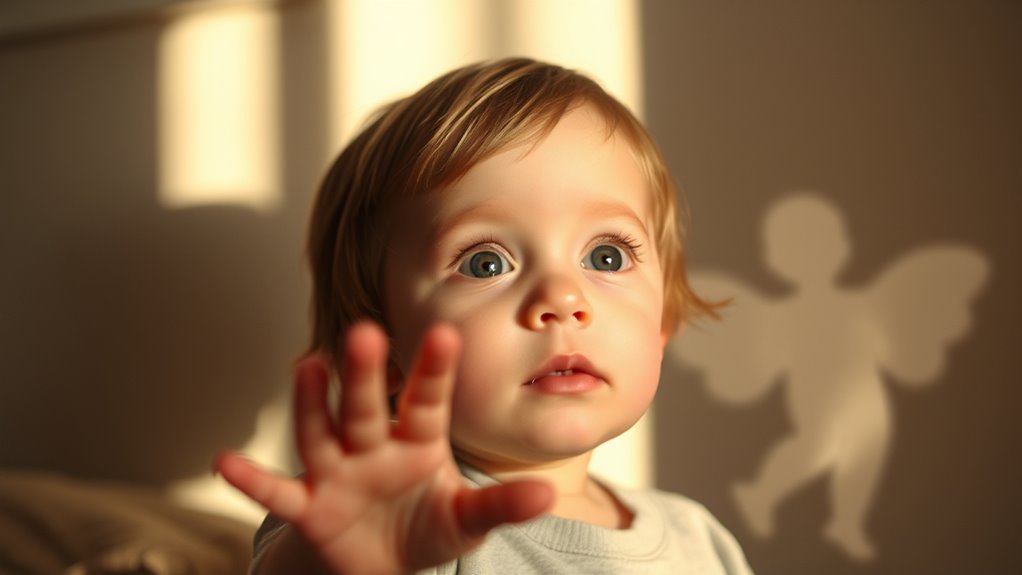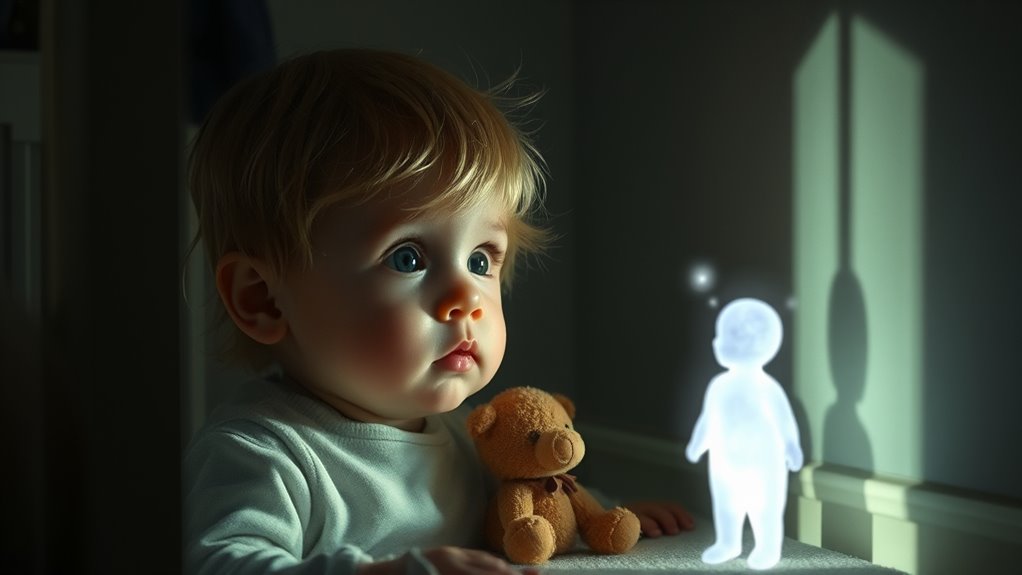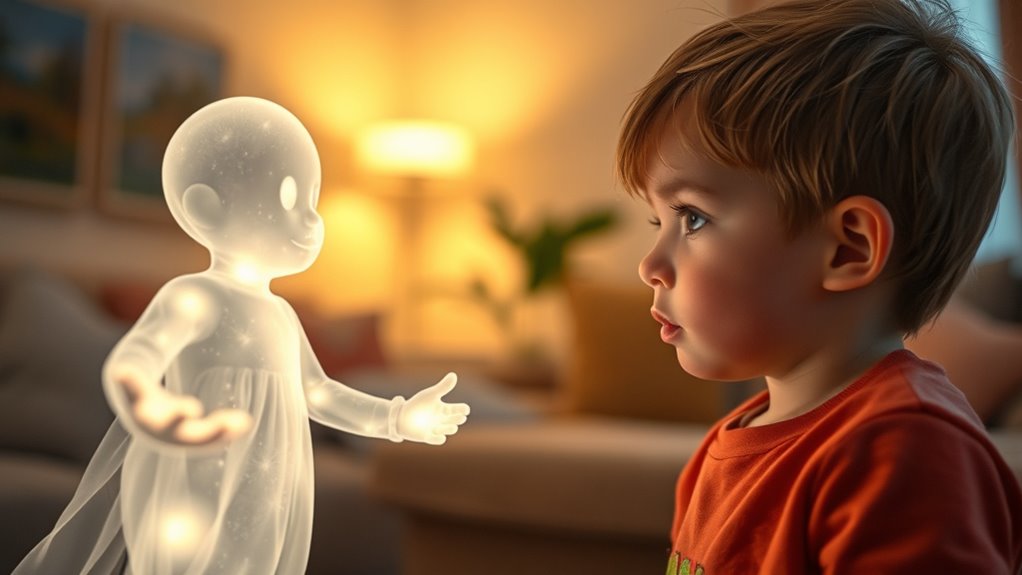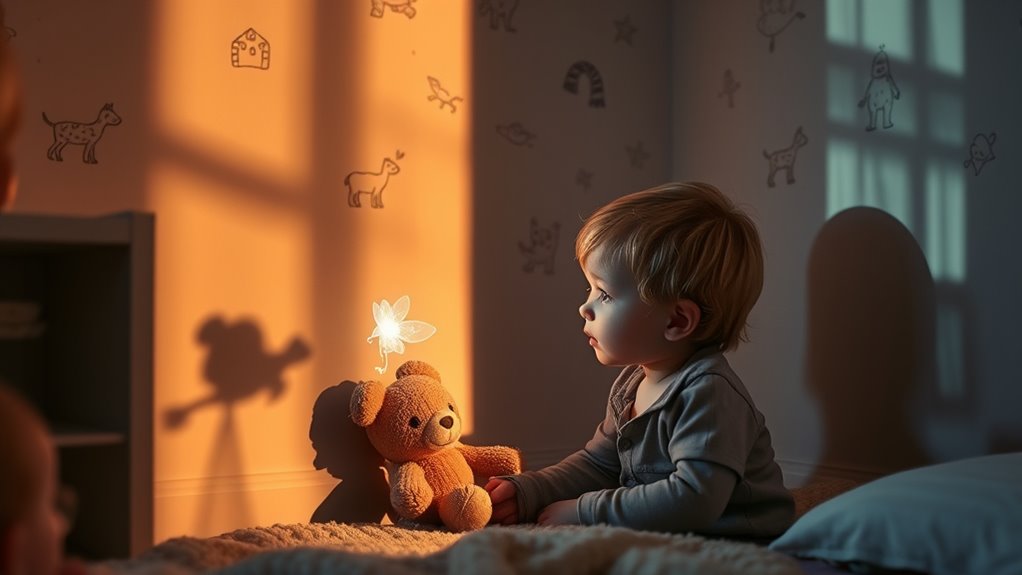If your child’s imaginary friend seems unusually present, causes fear, or involves strange noises or shadows, it might be more than just imagination. Watch for behaviors like persistent responses to unseen entities or vivid dreams with symbolism, which could suggest a spiritual connection. Understanding cultural beliefs and offering calm, supportive conversations can help. If concerns persist, seeking professional guidance is wise. Keep exploring the signs—they might reveal more than only imagination if you pay close attention.
Key Takeaways
- Observe if the child’s interactions are playful and voluntary, indicating healthy imagination, versus persistent, unsettling encounters suggesting possible spiritual presence.
- Look for signs like unexplained voices, shadows, or reactions to unseen entities that may point to spirit communication.
- Consider cultural beliefs and rituals that honor or protect children from spirits, which can offer context and reassurance.
- Engage calmly with your child about their experiences, validating feelings and setting boundaries between imagination and possible spirits.
- Seek professional guidance if the imaginary friend causes distress, persists beyond typical age, or interferes with daily life.
Recognizing Unusual Behavior in Your Child

Sometimes, children exhibit behaviors that seem unusual or out of the ordinary, and recognizing these early can help you understand their needs better. During child development, some kids create imaginary friends or engage in behaviors that might seem strange. These actions can be a normal part of their emotional support system, helping them process feelings or build social skills. However, it’s essential to pay attention to patterns and intensity. If your child consistently talks to someone unseen or isolates themselves, it might signal a need for additional emotional support or further observation. Being attentive and responsive to these behaviors allows you to nurture their development and ensure they feel secure. Understanding these signs can help you support your child’s growth and emotional well-being effectively. Incorporating emotional intelligence into your parenting approach can also enhance their social and emotional development. Additionally, knowing store hours can aid in planning activities and ensuring you have time to observe and support your child’s behavior. Recognizing that some dreams may have symbolic meanings can also help interpret their experiences and feelings. Recognizing the difference between normal imagination and signs of spiritual presence can be helpful for parents navigating these perceptions. For example, understanding aura colors and their meanings can provide insight into your child’s emotional and spiritual states.
Common Signs That Might Indicate a Spirit Connection

Noticing unusual occurrences or messages that seem to come from beyond can be an indication of a spirit connection. Your child’s behavior might include subtle signs of spirit communication, often rooted in childhood intuition. These signs can manifest as:
Unusual messages or sights in children may indicate a spirit connection and heightened intuition.
- Hearing unexplained voices or sounds when no one is around
- Seeing fleeting shadows or apparitions out of the corner of their eye
- Responding to questions or conversations with someone unseen
If your child shows these signs, it could suggest they’re sensing or communicating with spirits. Trusting their intuition is essential, as it often guides them to perceive things beyond normal perception. Recognizing these common signs can help you better understand your child’s experiences and the possible spiritual connection involved. Additionally, understanding the spiritual significance behind such behaviors can provide comfort and insight into your child’s unique experiences. Awareness of dream symbolism related to spirits can also offer valuable perspectives on their perceptions. Paying attention to their emotional responses can further help interpret their experiences and foster a supportive environment. Developing an understanding of spiritual communication may enhance your ability to support your child’s perceptions and reactions during these encounters. Incorporating an understanding of AI safety vulnerabilities might help you reflect on the importance of protecting sensitive information during such spiritual explorations.
Differentiating Between Imagination and Possible Paranormal Activity

You might notice your child’s imagination creating vivid stories or responses during play, which is usually normal. However, if they react to unseen presence or seem frightened without explanation, it could be a sign of something more. Learning to tell the difference helps you understand whether it’s simply imagination or something worth exploring further. Some signs of potential paranormal activity include persistent unexplained noises or others sensing a presence, which may warrant further attention. Additionally, noting the retail hours of local stores might help you plan to seek advice or support when needed. Understanding sleep solutions for young children can also be beneficial if sleep disturbances are involved, as they can sometimes be linked to fears or unseen influences.
Recognizing Imagination Signs
When children talk about their imaginary friends, it can be tempting to see it as simply a sign of childhood creativity, but it’s important to distinguish between harmless imagination and signals of something more concerning. Signs of genuine imagination often involve playful interactions that are consistent and voluntary. Look for these clues:
- The child can easily describe the imaginary friend and their activities
- The interactions are part of regular imaginary play, not intrusive or frightening
- The child shows no signs of fear or distress when discussing their friend
If these elements are absent and the child’s behavior feels intrusive or unsettling, it might indicate something beyond typical childhood creativity. Recognizing these signs helps you better understand whether it’s just imaginary play or something that warrants further attention. Additionally, understanding spiritual activity can aid in differentiating between healthy imagination and possible paranormal influences. Being aware of paranormal activity signs can help determine if what your child is experiencing is within normal bounds or if it might require professional guidance. It’s also helpful to observe whether the imaginary friend exhibits persistent presence or if the child’s interactions with it change over time.
Noticing Paranormal Indicators
While children’s imaginary friends are usually harmless, certain behaviors may suggest something more unusual. If you notice your child reacting to unseen presence, talking about energy awareness, or seeming to sense things others don’t, it could be a sign of paranormal activity. Pay attention to whether these experiences align with childhood dreams or vivid imaginations, or if they occur outside typical play. Unexplained cold spots, objects moving without cause, or reactions to invisible entities might indicate something beyond imagination. Trust your intuition—if your child consistently displays these behaviors and they feel unsettling, it’s worth exploring further. Differentiating between normal childhood dreams and potential paranormal indicators requires careful observation and an open mind.
Cultural Beliefs and Traditions Regarding Child Spirits

Many cultures see child spirits as meaningful, often linked to ancestors or protective forces. You might find that specific rituals or charms are used to honor or safeguard these spirits. Understanding these traditions can help you appreciate different ways families interpret and care for their children’s unique spiritual experiences.
Cultural Interpretations of Spirits
Throughout various cultures, spirits believed to be related to children often hold deep symbolic significance and are woven into local traditions and stories. These spirits are seen as messengers, protectors, or symbols of innocence, influencing how communities interpret child behavior and imagination. In many cultures, spirit communication with children is viewed as a sacred or meaningful exchange, reinforcing cultural symbolism around purity and spiritual connection. You might find that:
- Child spirits represent ancestral ties or spiritual guides.
- They are believed to aid in fostering moral values.
- Their presence often signals spiritual protection or blessing.
These interpretations shape how families respond to children’s imaginary friends, blending cultural beliefs with personal experiences. Recognizing these cultural nuances can help you better understand the spiritual significance attributed to such spirits across different traditions.
Rituals and Protective Measures
Cultural beliefs about child spirits often include specific rituals and protective measures designed to honor or safeguard these entities. You might incorporate meditation practices to create a calm environment, helping your child connect respectfully with their spirit friend. Family rituals, such as offering small blessings or lighting candles, serve to acknowledge the spirit’s presence and guarantee its positive intention. These practices can also help your child feel safe and supported, reinforcing boundaries between the physical and spiritual worlds. Respectful acknowledgment through rituals shows reverence and can reduce fear or anxiety. Remember, each tradition varies, but the goal remains to maintain harmony, protection, and respect for the spirit, fostering a nurturing space for your child’s unique experiences.
How to Approach Your Child About Their Friend

When you’re ready to talk to your child about their imaginary friend, choose a calm, relaxed moment to start the conversation. Approach with curiosity and openness, avoiding judgment. Remember, understanding child psychology and developmental milestones helps you interpret their behavior accurately. You can say something like, “Tell me about your friend,” which encourages dialogue without dismissing their feelings. Keep these points in mind:
- Show genuine interest to foster trust
- Avoid dismissing or criticizing their imagination
- Observe their reactions and listen carefully
When to Seek Professional Guidance

If you notice that your child’s imaginary friend persists beyond the typical age or seems to interfere with their daily activities, it’s time to contemplate seeking professional guidance. Concerns about child development or mental health can arise if their behavior causes distress or isolation. A mental health professional can evaluate whether the imaginary friend is part of healthy imagination or a sign of underlying issues. Trust your instincts—early intervention can provide support for your child’s emotional well-being.
| Signs It’s Time to Seek Help | Emotional Impact on Your Child |
|---|---|
| Age beyond typical developmental stages | Feelings of loneliness or fear |
| Severe withdrawal from peers | Anxiety or depression signs |
| Disruptive or aggressive behavior | Loss of confidence or trust |
| Persistent imaginary interactions interfering with routines | Emotional distress or confusion |
Protecting Your Child’s Well-Being Spiritually and Emotionally

As you observe your child’s imaginary friend and consider whether it signals underlying concerns, it’s also important to nurture their spiritual and emotional health. Establishing spiritual boundaries helps your child differentiate between imagination and reality, fostering a sense of safety. Encourage open conversations about feelings to build emotional resilience, so they can cope with fears or confusion. You can also:
- Promote grounding routines, like prayer or positive affirmations
- Reinforce a loving, secure environment
- Respect their feelings without dismissing their experiences
Practical Steps for Addressing Your Concerns

Taking practical steps to address your concerns about your child’s imaginary friend involves observing their behavior closely and maintaining open communication. Understand that childhood fantasies are normal and can serve as a healthy way for children to process their emotions. Use parenting strategies that encourage your child to share their experiences without judgment, helping you assess whether their imaginary friend is causing distress or simply part of their imaginative play. Set gentle boundaries if needed, and provide reassurance to ease any fears. Engage in activities that promote real-world interactions and social skills. If you notice ongoing anxiety, withdrawal, or other concerning behaviors, consider consulting a pediatrician or child psychologist. These steps help you support your child’s emotional development while respecting their imaginative world.
Frequently Asked Questions
Can a Child’s Imaginary Friend Be a Benevolent Spirit?
You might wonder if an imaginary friend could be a benevolent spirit. As your child’s psychic development unfolds, they may naturally sense spirit communication, which can manifest as imaginary friends. These friends often serve as a way for your child to process emotions or experiences. Trust your intuition—if you feel a positive presence, it could indeed be a spirit offering guidance or comfort during this special stage of awareness.
Are There Specific Signs That Differentiate a Spirit From a Hallucination?
Think of distinguishing a spirit from hallucination as spotting a shining star in a cloudy sky. Signs include consistent presence, meaningful communication, and reactions that seem beyond mere mental health issues. Unlike hallucinations caused by psychic phenomena or mental health concerns, spirits often show signs of awareness and intent. Trust your intuition, observe behavior, and seek guidance if you’re unsure—these clues help you tell the difference.
How Do Different Cultures Interpret Child-Spirit Interactions?
Different cultures interpret child-spirit interactions through their unique spiritual beliefs and cultural perspectives. Some see these encounters as meaningful communications with ancestors or spirits, while others view them as innocent imagination or psychological phenomena. You might notice cultural rituals, stories, or symbols shaping these perceptions, emphasizing spiritual interpretations that honor tradition. Recognizing these diverse beliefs helps you understand that such interactions can be seen as significant, sacred, or simply playful depending on cultural context.
What Rituals or Spiritual Practices Can Protect Children From Negative Spirits?
Imagine the safety of your child’s world shining brighter than a thousand suns. You can do this by using protective charms like amulets or talismans, which act as powerful shields. Regular spiritual cleansing, such as smudging or prayer, clears negative energies. These practices create a barrier, ensuring your child stays safe from negative spirits, letting their imagination flourish in a protected, peaceful environment.
Is It Safe to Attempt Communicating With a Child’s Spirit Friend?
You might wonder if communicating with your child’s imaginary friend is safe. While many believe imaginary friends are harmless, some myths suggest they could be spirits. To keep your child safe, focus on childproofing tips like setting boundaries and monitoring interactions. Remember, most imaginary friends are just a normal part of childhood development. Trust your instincts, and if you’re concerned, consult a professional to guarantee your child’s emotional well-being.
Conclusion
While it’s natural to wonder if your child’s imaginary friend might be a spirit, remember that most are harmless and part of healthy imagination. Trust your instincts, observe behavior, and consider cultural beliefs. If concerns persist or behaviors seem troubling, seek guidance from professionals. Protect your child’s emotional and spiritual well-being by staying attentive and supportive. Ultimately, understanding the line between imagination and the paranormal helps you nurture a safe, trusting environment for your child’s growth.








